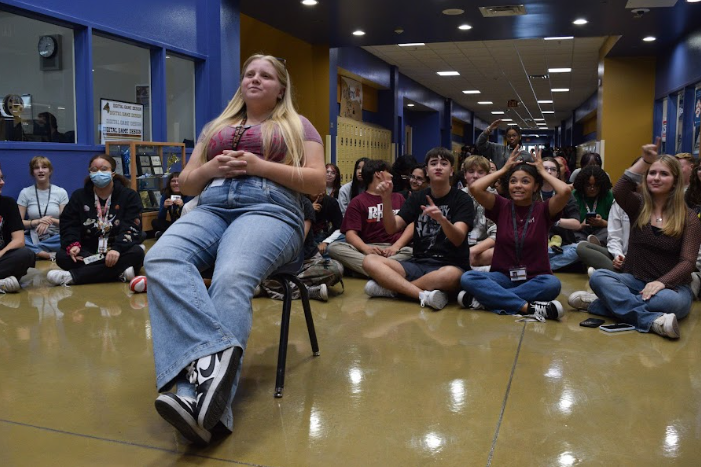In between clips of Reddit stories on the backdrop of Subway Surfers gameplay and “Get Ready With Me” videos, the average TikTok scroller might get a Daily Mail headline or a Philip DeFranco explainer trimmed to under a minute. These bursts of news are enough for consumers to feel like they are relatively informed, but they often fail to capture the full story. For many, being informed begins and ends with the tidbits of news they see on social media.
Roughly three in five U.S. teens now get their news from social media platforms like YouTube, Instagram, and TikTok; the transition has pulled people away from vetted journalism and toward content that is more digestible, but less verified.
“I would say that I’m pretty up to date with the news, though, it’s not from credible sources—it’s from TikTok,” senior Eloisa Valelo said. “I still know what’s going on in the world, just maybe not to the extent I want to be.”
English 9 teacher Kristina Haley has personally noticed this shift away from established sources in both her classroom and the general population.
“It’s indicative of the average American,” Haley said. “They don’t know what the difference is between sensationalized news versus news organizations with actual journalistic integrity, and I think that a lot of the time, they just get lumped in together.”
Even among adults, there’s confusion around what counts as legitimate journalism: a 2024 Pew Research study showed that over half of U.S. adults consume their news, at least occasionally, through social media.
“My own mother gets all of her news from TikTok,” Haley said. “When I told her she should be getting her news from a vetted source like Reuters or the Associated Press, she had no idea what either of those were.”
The effects of this shift extend beyond social habits, as the decline in trust for journalism has broader consequences for our form of government.
“I don’t think we can have a functioning democracy if we don’t have an educated populace,” Haley said. “If people don’t know where to go to get true information, then how can we function?”
As more people turn to social media for information, concerns about misinformation have grown. Another Pew study from 2023 reported that 40 percent of adults who get their news this way say they regularly encounter stories they suspect are inaccurate.
“When the news is heavily biased, or when creators don’t show both sides, people get a twisted version of the story,” junior Faris Gibirila said. “We need more exposure to both sides, especially when it comes to political arguments or stories about other countries.”
The decline in traditional news consumption has also impacted how students engage with information in school. Educators have noticed that students are less likely to read full articles and more likely to rely on secondhand summaries.
“They [students] get all of their news, whatever news it is, through social media and memes,” Haley said. “None of them are actually going to news sources and vetting authors or comparing coverage. That’s just not happening.”
While some students still try to stay informed with credible, thorough reporting of the news, the convenience of short-form content makes it difficult.
“As a student journalist, I spend a lot of time researching topics and going out to get interviews and make a lot of drafts, so it’s disappointing when I hear people don’t actually read the stories fully,” Valelo said. “Our local news in the newspaper concerns us the most, so people should put more focus on looking at news in their communities.”
The shift away from vetted journalism has raised broader concerns about media literacy and civic engagement. Without clear standards for where and how to get information, the line between fact and opinion continues to blur.
“People’s trust in journalism is like tanking, and nobody knows where to go for trustworthy information,” Haley said. “While that’s happening, there’s also AI happening over here, and deep fakes happening over here, and bad actors who know that they’re spreading fake news. The turning of news into entertainment has undermined people’s trust in news, and people need to come back to intellectualism, not the other way around.”


![Weighing her options, senior Allyana Abao decides between going on a practice drive or calling an Uber. Though unlicensed, Abao has considered driving to be a significant milestone of teen independence despite alternatives that provide much easier solutions.
“You're able to be independent and not rely on others,” Abao said. “You're able to get a job, get things that you need, go places you need to go. I have so many places that I want to go to and I ask [my family] for so much. I want to be independent to where they know that I can do things on my own, so they know that they don't have to be there for me.”](https://southwestshadow.com/wp-content/uploads/2025/10/IMG_2922-1200x900.jpg)
![Looking at the board, former BSU secretary Christina Altaye begins to prepare for BSU’s second year of Club Feud. This year, “Are You Smarter Than a Ninth Grader?” will be replacing this event. “I think it’s a fun change [to Club Feud],” BSU Activities Director Hellen Beyene said. “[I think] it’s always fun to do something new and different.”](https://southwestshadow.com/wp-content/uploads/2025/10/Screenshot-2025-09-29-11.06.43.png)


!["I will be attending Trunk or Treat [for FCCLA]" junior Crystal Li said. "We're gonna use Mr. Harbeson's car, and we will be [hosting three different activities]."](https://southwestshadow.com/wp-content/uploads/2025/10/IMG_0980-1200x900.png)

![Grabbing her phone to take a photo, sophomore Vanessa Ta sits down on a bed and takes a couple photos to post on her social media. “I just really [feel] that my favorite cosplayer is everyone lowkey, because I get to see people’s creativity,” Ta said. “I get to see how skilled and talented they are.”](https://southwestshadow.com/wp-content/uploads/2025/10/55A1FC60-BE63-4F24-9B78-65194336319E-e1760926431267.jpg)
![In his fifth period World History class, Thur works with his students individually, helping them as they sort through notes and assorted historical documents. “I’m always willing to try something new,” Thur said. “Some of my best ideas that I’ve received over the years are from students. This year I’m trying out stations for the first time and kids are rotating through and it’s working. Well, some things are [working], I’ve still got to work out the kinks with it. The kids change, why shouldn’t I change too?”](https://southwestshadow.com/wp-content/uploads/2025/10/IMG_8991-1200x800.jpg)
![Fast food has not stayed the same principle of “sit down, order, and get food,” but has turned into a process with multiple layers and complexity. This is largely due to the integration of automation in every aspect of dining. “I'm not that knowledgeable on it, but I've seen videos on TikTok, I'm not really concerned—it doesn’t seem that smart,” senior Dallas Evertt said. “When [some people are just ordering] 18,000 water cups, it sounds really dumb. There was no way [the AI] was gonna put down 18,000 water cups—and that just shows how it’s not going to take anybody’s job soon.”](https://southwestshadow.com/wp-content/uploads/2025/10/Dominante-Image-1200x675.png)
![Squaring up to a practice dummy, sophomore Cypher Andres prepares to throw a punch. Dummies are regularly used to help him prepare certain hits to take his opponents down. “[Boxing dummies help me practice] because it’s basically a model of the body,” Andres said. “It helps with accuracy, such as pressure points behind the ear, and a clean liver shot can end the fight.”](https://southwestshadow.com/wp-content/uploads/2025/10/IMG_5728-e1759850486200-1200x864.jpg)
![Swaying and preparing to toss the tennis ball, Dylan Grove practices serving. Grove had been training in preparation for her upcoming matches against Chaparral and Doral Red Rock. “[Both teams are] both very tough opponents, but I am ready for whatever gets thrown my way,” Grove said.](https://southwestshadow.com/wp-content/uploads/2025/10/image-1200x900.png)